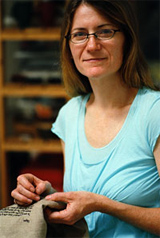
Written by Mary Shafer
Education
Ph.D., M.A., philosophy, Washington U (St. Louis); M.F.A., studio arts, U of Illinois at Chicago; B.A., art/biology, Bucknell U
What it takes to be an artist…
“Certain things about art are physically immersing, and that’s very rewarding. But there are also parts that are very difficult. There’s a lot of failure in art. So you need stick-to-it-iveness, and that’s a process. There are many ways to be an artist. Pay attention to what resonates.”
What her students might say…
“I’m very excited about what I do, and I think that’s contagious. I can be pretty conceptual in my approach. Some like that, others don’t. I expect students to think critically. They might find that surprising. And they sometimes say I talk a lot!”
If she weren’t a professor, she might…
“Be running an outfitter company.”
What she’s most proud of…
“Probably the ‘Ad Infinitum’ video. Things always change, but the video is a substantial work. It’s an attempt to deal with questions that I think have resonance with many of us.”
On a hot July afternoon, Jan Estep is at work in her office in the Regis Center for Art. She has spent the morning mulching her garden, a physical, hands-in-the-dirt activity that she claims nicely balances her previous day’s marathon work session at the computer.
It’s the kind of balance on which Estep thrives. She is a writer who paints, a sculptor who embroiders, an undergraduate biology major with a Ph.D. in philosophy, and an assistant professor with a faculty appointment in the University’s Department of Art—where she teaches photography.
“For some reason, I can’t just do one thing,” Estep laughs. “I like what happens when you bounce back and forth between media.”
In Estep’s case, “what happens” is usually a multisensory feast of words and images. To get a taste of her work, witness her exhibition “Areas of Inaccessibility,” which she developed between 1998 and 2004. The subject is Antarctica, a wilderness that intrigues her because “I could never fully know it,” she says.
To explicate this theme of exploring the unknowable, Estep created a large (11-by-13-foot) topographical map of Antarctica (Topo Antarctica), using layers of Polartec®. She also made an expedition suit modeled on turn-of-the-century outfits and created black-and-white photographs of polar explorers, inserting herself into the picture—dressed in that suit.
In a graphic rendering of the quest, she sketched abstract drawings based on maps of shipping routes. She created a wall piece, etching text from vinyl and calling it “Because snow never melts,” a reflection on what it might be like if thoughts were like the never-melting snow that falls on Antarctica.
She embroidered blankets with the Antarctic explorer Ernest Shackleton’s words, “Optimism is true moral courage,” and created a video with an image of a ship’s prow breaking through the ice as scrolling text names the ships that took part in expeditions searching for Antarctica.
Creative Mixing
Mixing media—and so allowing each to contribute its unique perspective to an idea—comes naturally to Estep, who once talked a college professor into letting her draw her science experiments. For a time, she considered becoming a medical illustrator as a way of mediating the tug-of-war between her practical and artistic sides. But in her last year of college, she took a philosophy course and, in another twist—and despite the “shoulds” about practicality that echoed in her head—decided to study philosophy.
“Actually, I went to graduate school ill-prepared,” she reflects. “My peers were better writers, better thinkers. But I had great desire to know lots more than I knew. I’m always putting myself in situations I don’t quite understand. Getting too comfortable makes me dissatisfied.”
Along the way to her philosophy Ph.D., she made a promise to herself: If she finished her dissertation, she would go to art school—and so she did, earning an M.F.A. from the University of Illinois at Chicago, where she also taught philosophy.
But what about art as a career?
“Art is not necessarily a practical choice in terms of jobs,” Estep admits. “I sympathize with that. What it does, though, is expose you to a way of creative problem-solving, of cultivating the life of the imagination so you can answer questions.”
In her case, it did lead to a job—at Chicago’s New Art Examiner magazine, where she was senior editor until the magazine folded in 2002. Then the faculty position at the University opened up, and the nimble, intellectually restless Estep was just what the art department was looking for.
These days, Estep is mixing it up as much as ever, creating exhibitions like “Ad Infinitum,” a video in which an optimist and a skeptic debate their ideas while traveling through the desert. True to form, she accompanies it with a series of drawings and word poems based on the place names of various sites in the desert landscape.
She also embroidered text pieces that record the history of the term “skepticism” as traced in the Oxford English Dictionary and Descartes’ Meditations.
Grounded in ideas that are as diverse as her media, Estep’s art truly defies definition. “Technique isn’t the only thing, and may not be the primary thing,” Estep says. “There’s more to being an artist than knowing how something comes together. To do something well, you need thought behind it. It’s all idea-driven.
“In my classes I stress, ‘We’re going to talk about this thing you’re making, but also why you’re making it. How is it related to your background? You can bring all sorts of things into your art. You can open up.’”